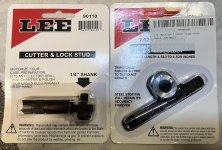Update, I trimmed the yoke barrel a little bit. It was out of square, and is correct now, but did not change the condition. I only took about 0.005" off, with no perceptible change in performance. There's still a hard spot on one or two of the cylinders. I may look at the internals next, since I've been wanting to learn about them. Comments appreciated.
Several things. Does the cylinder have
any end shake at all? If you took .005" off the yoke arbor it should have some. It needs to have about .001-2" at minimum, but very little more. If you can feel any end shake there should be enough clearance between the ratchet and breech face. If not then the yoke could still be the problem.
If you pull the hammer back to lower the cylinder stop so that the cylinder can be freely rotated by hand while latched into the frame does the cylinder turn freely then, or is the bind just when the cylinder is closed and noticed when cocking
either single or double action?
Maybe I asked this in my first post in this thread, but did you have the binding problem before re-barrelling the gun? If not then you need to be looking at things related to that change. It is not impossible that the frame is distorted (bent, warped, "tweaked", pick the word! It is not impossible the gas ring is binding on the yoke too. I did see this once on a revolver that had just been returned from repairs at the factory!
Then there is a matter of nomenclature. Revolvers have
one cylinder, the cylinder contains several chambers aka charge holes!
If you haven't cured the problem with what have already done you really need to have someone look at the gun who understands the S&W mechanism better than you. No insult intended, just fact. I say this because there is one thing that is paramount, don't cut or file anything until you are
sure you know where the problem is, Unfortunately you have already violated this.
Just trying to give you all the possibilities.

